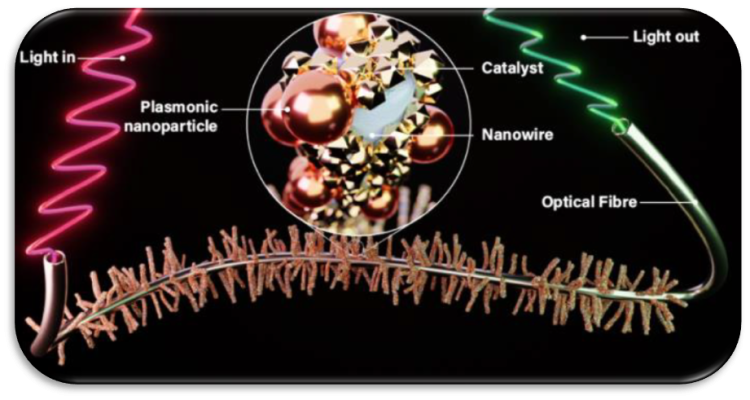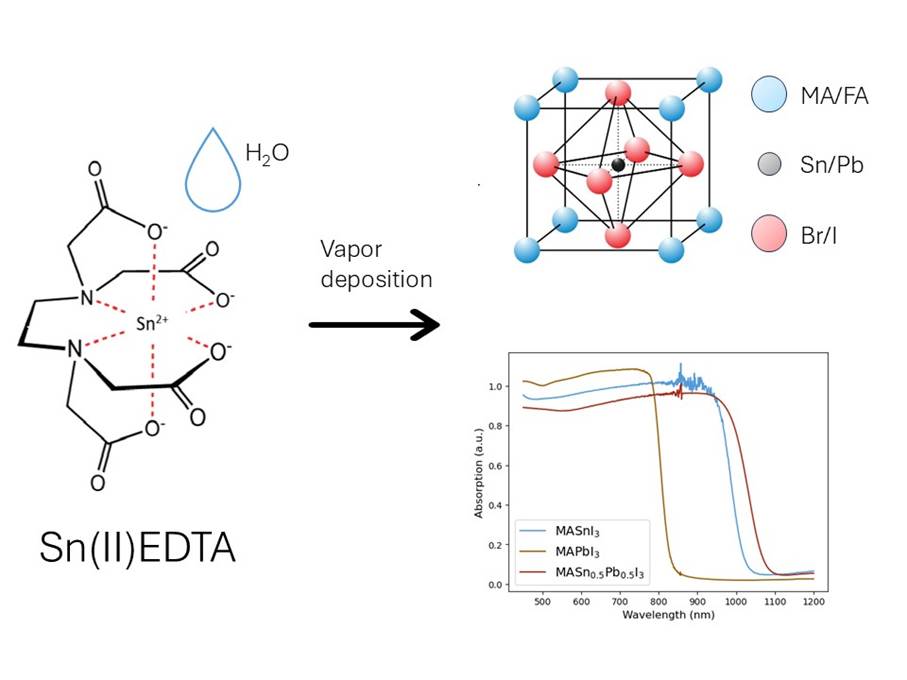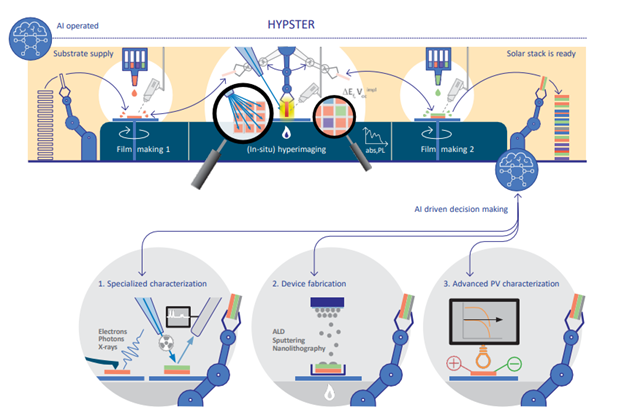
Research activities Nanoscale Solar Cells
Overview
The group synthesizes advanced metal and semiconducting nanostructures, characterizes their material properties and integrates them into novel device structures with the aim of improving our fundamental understanding of light absorption, charge separation, recombination and transport at the nanometer scale.
We have 2 main focus areas: improving halide perovskite solar cells and using light to drive and monitor chemical reactions.
Our current projects
- Electron backscatter diffraction of operating halide perovskite solar cells
- Nikolai Orlov
- Design of a catalytic reactor driven and monitored with light
- Elaina Galvin
- Heterojunction interfaces for silicon-perovskite tandem solar cells
- Sarah Gillespie
- Vibrational strong coupling for electrocatalysis
- Jyoti Lather
- Concentrating diffuse light with halide perovskites
- Jérôme Gautier
- Marcel Kouwenhoven
- Omolara Adisa
- Daan Methorst
- Fanny Thorimbert
- Plasmonic nanoreactors for CO2 reduction
- Rohit Raj
- Stable intermediates for Sn-based halide perovskite solar cells
- Linde van de Ven
- Advanced optical measurements on halide perovskites
- Shi-Wei Yuan
- Automated halide perovskite solar cell fabrication and analysis
- Basita Das
Electron backscatter diffraction of operating halide perovskite solar cells
Brainpower: Nikolai Orlov
Halide perovskites have emerged as the most exciting new semiconductor for optoelectronic devices (solar cells, LEDs, radiation detectors) over the last decade. Despite all advantages some of them have poor stability and degrade under light. The project is aimed to study the microscopic structural origin of perovskites degradation under applied light bias.
Within the project our group will develop light incoupling system for Scanning Electron Microscope that in combination with highly sensitive EDAX Clarity detector allows to track in operando changes in crystal phase, orientation, and distribution under optical bias.
Studying perovskites by EBSD also requires optimization of measurement parameters and procedure. Having large experience in working with beam-sensitive materials we develop new approaches in EBSD analysis on beam-sensitive materials using both materials science (protective coatings) and computational (machine learning) methods.
Design of a catalytic reactor driven and monitored with light
Brainpower: Elaina Galvin
The chemical industry produces critical products such as crop protection, plastics, fertilizers, and fuels. Most chemical reactions use catalysts to reduce the necessary energy input. Nevertheless, the industry relies heavily on the combustion of fossil fuels to meet the substantial energy needs, resulting in significant annual greenhouse gas emissions. An approach to mitigating these emissions is to advance catalyst selectivity and activity, while ensuring the use of renewable energy sources to drive production.
We are developing a light driven catalytic reactor which uses plasmonic nanoparticles as nano-heaters combined with catalytic particles (see image). By using pulsed light, we can dynamically induce reactions overcoming steady state limitations. The incorporation of smart light steering within the reactor facilitates localized heating at catalytically active sites and enables real-time monitoring of induced reactions and temperatures. Both simulations and experiments will be used to characterize reactions and to minimize losses. This is a highly interdisciplinary project in collaboration with research groups at AMOLF and Utrecht University, and with industrial partners.

Heterojunction interfaces for silicon-perovskite tandem solar cells
Brainpower: Sarah Gillespie
In recent years, halide perovskite solar cells have reached an astonishing efficiency record of 26.1% (approximately 85% of the Detailed Balance Limit) [1]. The remaining losses arise primarily from interfacial carrier recombination and from resistive losses due to non-ideal contacts. This project aims to simultaneously tackle the remaining challenges by developing passivating contacts that can reduce interfacial recombination, improve charge transport and, furthermore, enhance absorption near the band edge of the perovskite by reducing parasitic absorption at the contact.
The primary focus is to investigate whether passivating contacts now becoming the standard for high efficiency silicon solar cells (such as doped polysilicon/SiO2, doped hydrogenated amorphous silicon and metal oxide contacts) can be applied to halide perovskite single junction devices and perovskite-silicon tandem solar cells.
A parallel goal of this project is to develop advanced optical characterisation methods to directly study the influence of various interfacial contacts on the full cell performance. These methods can allow for rapid screening and optimisation of prospective next-generation contacts without the need to fabricate full devices. We have already shown how time-resolved photoluminescence spectroscopy can be extended to resolve the photovoltage losses across any perovskite stack (see figure), and we are currently assessing whether advanced photoluminescence analysis of perovskite films alone can predict the long-term quality and stability of the full perovskite solar cell [2].
This work is in collaboration with the Solar Energy department at TNO and research is conducted across both AMOLF and TNO.

[2] S. C. Gillespie et al, “Silicon Inspired Analysis of Interfacial Recombination in Perovskite Photovoltaics”, Submitted, (2024)
Vibrational strong coupling for electrocatalysis
Brainpower: Jyoti Lather
Vibrational strong coupling (VSC) has an attracted attention in the past couple of years due to potential applications for controlling the chemical reactions and material properties. VSC is a phenomenon in which molecules are confined in the electromagnetic field using optical and plasmonic cavities. This hybridization of light and matter leads to new energy states called polaritons. We are developing plasmonic cavities to confine the electromagnetic field at subwavelength level for electrocatalysis.
Our main goal of the project is to explore for the ideal electrocatalyst by controlling the optical environment in reaction. The strategic integration of electrocatalysis with VSC is to improve the overall electrocatalytic processes. Electrocatalyst provide binding sites for a key intermediate, thereby reducing the transition state energy. Our idea is to fabricate the plasmonic cavities in the mid infrared spectral range that can couple to specific molecular vibrational of reaction intermediate. This demonstration can change the binding energy of the specific reaction and opens the completely different approach for controlling electrocatalyst activity.
Concentrating diffuse light with halide perovskites
Brainpowers: Jérôme Gautier, Marcel Kouwenhoven, Omolara Adisa, Daan Methorst, Fanny Thorimbert
The goal of this project is to combine materials science and nanophotonics to overcome the low energy density of sunlight for solar cell applications. To mitigate this issue, various solutions have been proposed, such as increasing the efficiency of solar cells or using solar concentrator.
Our approach starts with halide perovskites, a class of versatile semiconductor in which we can tune the bandgap and locally change their composition under illumination. The study and characterization of the entangled process regulating this behaviour spans in timescale ranging from femtosecond to minutes and required a suit of homebuilt tools and a great expertise in material science. The halide perovskites are then integrated into our nanophotonic design to collect diffuse light, concentrate it in our material and collimate the quasi-monochromatic emission. At its core, we are creating an integrated device with an extreme asymmetry between the absorption cross section and the emission.
Plasmonic nanoreactors for CO2 reduction
Brainpower: Rohit Raj
Artificial synthesis of hydrocarbons from carbon dioxide (CO2) holds the potential to provide renewable fuels at the scale needed to meet global decarbonization targets. However, CO2 is a notoriously inert molecule and converting it to energy dense hydrocarbons is a complex, multistep process, which can proceed through several intermediates. Recently, the ability of plasmonic nanoparticles to steer reactions through specific pathways, enhance both reaction rates and selectivity has attracted significant attention due to its potential for sustainable energy production.
Plasmonic nanostructures have unique optical properties that enable them the ability to concentrate light in sub-nano scale volumes. Molecules interacting with this concentrated light can undergo chemistry which is otherwise inaccessible by traditional thermal catalysis. Extreme light confinement, in addition to driving interesting chemistry at the surface of the nanoparticle, can also be used to probe molecules using highly sensitive spectroscopic techniques like surface-enhanced Raman scattering.
CO2 reduction reaction (CO2RR) proceeds via different intermediates leading to the formation of multiple products, often yielding poor selectivity. My PhD aims to understand the underlying mechanism in plasmonic CO2RR, study and control the product distribution via promoting/inhibiting the formation of specific intermediates at a single particle level using light. The success of this project will take us a step closer to using CO2 as feedstock for fuels and achieving a circular economy.
Stable tin-based perovskites via novel intermediates
Brainpower: Linde van de Ven

Automated halide perovskite solar cell fabrication and analysis
Brainpower: Basita Das
Halide perovskites have emerged as leading candidates for the next generation of single- and multi-junction solar cells owing to their tunable bandgaps, long carrier lifetimes, and high carrier mobilities. Their vast chemical design space allows fine-tuning of both optical and structural properties through different combinations of A-site, B-site, and X-site elements. Yet, the same tunability that makes halide perovskites so versatile also underlies their instability. Ion migration, halide segregation, defect formation, and phase transitions from photoactive to non-photoactive states under operating conditions continue to limit device stability. Nevertheless, given the breadth of chemical and experimental space in mixed halide systems, it is highly likely that stable combinations can be discovered.
This vast design landscape, together with their relevance for next-generation photovoltaics and other optoelectronic devices, and their relatively simple and rapid fabrication, makes halide perovskites ideal candidates for automated synthesis and characterization. To address this, we are developing a platform that autonomously fabricates perovskite solar cells and performs hyperspatial, spectral, and temporal optical characterization. This advanced tool enables millions of spectrally and temporally resolved measurements on a single sample across different pixels. Such miniaturization and parallelization not only accelerate experiments but also minimize variance that arises from comparing separately synthesized samples.
To maximize the value of the platform, we are coupling the generated data with AI models trained to predict material properties and stabilization strategies. This automated synthesis–characterization–AI loop is designed to probe chemical dynamics, materials and device optimization, and guide the discovery of stable, high-performance perovskite materials. The project is highly interdisciplinary, requiring collaboration among experts in advanced optical characterization, automated workflows, and perovskite photovoltaics. Together, with these combined insights, we aim to realize the HYPSTER platform at AMOLF.


